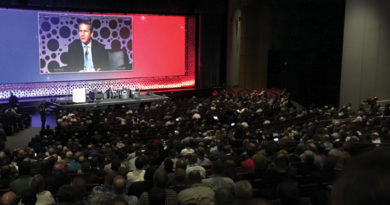Network Migration Strategies
By Jeff Howe
Cable operators have many options available to augment their existing HFC networks, but no clear path forward. Fortunately, there are several potential evolutionary paths — standalone or in combination — that can be tailored to specific applications.
Gigabit per Second Services in Both Directions
Historically, upstream bandwidth has lagged behind downstream usage. Today, the usage of the Internet itself is shifting. Cloud-based services allowing consumers to upload files for playback, storage, and backup are dramatically increasing the demand for upstream bandwidth.
If operators’ downstream capacity has caught up and surpassed the demand, they may be able to slow down the growth in advertised “Billboard Bandwidth” rates. DOCSIS 3.1 and upcoming full duplex technology address the increased demand for upstream bandwidth.
Node Splitting to Increase Narrowcast Services
Service group (SG) splits, or node splits, divide the number of subscribers connected to a single SG into two smaller groups. While node splits offer no change in bandwidth requirements for broadcast services, they effectively double the capacity per subscriber for narrowcast services.
A point of diminishing returns is reached when the SG nears 50 subscribers. Depending on the current average SG size, nodes splits can provide an effective migration strategy for another decade.
Full Duplex DOCSIS Powers Increased Upstream Bandwidths
Full duplex (FDX) DOCSIS is designed to provide 10 Gbps downstream and 5 Gbps upstream within an SG. In order to expand the upstream bandwidth while having minimal impact on the downstream bandwidth, FDX allows portions of the spectrum to be used for upstream and downstream transmissions simultaneously. The spectrum from 108 MHz to 684 MHz is designated for these bi-directional transmissions.
Reclaiming Video Spectrum
Although high speed data (HSD) is the industry’s fastest growing service, MSO-managed video services still consume the largest percentage of spectrum. The future will likely see operators using different mixes of broadcast digital video, SDV, VoD, IP video, and analog video. The analog video spectrum can be reclaimed using DTAs and media gateways with low-cost IP-STBs. As SGs become smaller, SDV can effectively reclaim broadcast video spectrum. Operators can also transition away from MPEG-TS based QAM digital video to IP-based video over DOCSIS.
Increasing Upstream Bandwidth to Meet Subscriber Demands
Migration strategies are dependent on transitioning to DOCSIS 3.1 CMs (and eventually FDX CMs), as well as dramatically increasing upstream bandwidth to provide symmetric services, typically to meet competitive pressures (e.g., Google Fiber). Some operators may be able to meet the short-term upstream bandwidth demands by migrating to an 85 MHz mid-split. Others may need to migrate quickly to a 204 MHz high-split.
Although the FDX band is 576 MHz wide, operators may not desire to use this entire spectrum for FDX initially, or may be limited by how much spectrum can be freed from other services. The specification allows only a portion of the FDX band to be used for FDX channels. However, the portion of the FDX band not being used for FDX channels can only be filled with video QAM channels. This is because FDX CMs can only use the FDX band for FDX channels. Depending on other factors such as spectrum availability, upstream bandwidth demand, and FDX CM penetrations, operators may choose how slow or fast to allocate FDX channels.
Many Technology Options
With the new demands driving bandwidth growth such as the competitive pressure to provide symmetrical upstream and downstream bandwidth services, some see FDX DOCSIS as the answer to solving all problems. However, one technology is not going to solve every problem.
Cable operators will require a whole toolkit of technologies to address their network migration needs. Those tools include node splitting and segmentation, DAA vs centralized architectures, DOCSIS 3.1, HFC vs. FTTH, RFoG vs. PON for FTTH, selective subscriber migration, etc. Taking advantage of those tools provides a variety of network migration options.

 Jeff Howe
Jeff Howe
VP, Systems Engineering
ARRIS
Jeff Howe is responsible for directing architectural work for CCAP and remote PHY products. Previously, Jeff was Director, System Architecture at Cadant, where he led architecture and integration work for the C4 CMTS. Jeff also served in managerial, architectural, hardware and software development, and test roles at Lucent Bell Laboratories for various data communications platforms. Jeff has a BSEE from the University of Wisconsin, an MSEE from Stanford University, and an MBA from Capella University.
The complete paper is available to SCTE•ISBE members at:
https://tinyurl.com/y8b2h8yk




